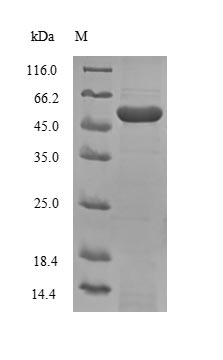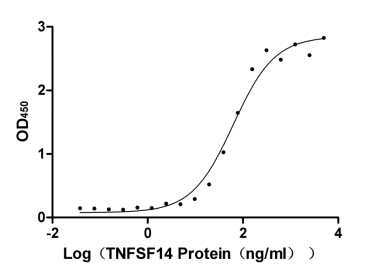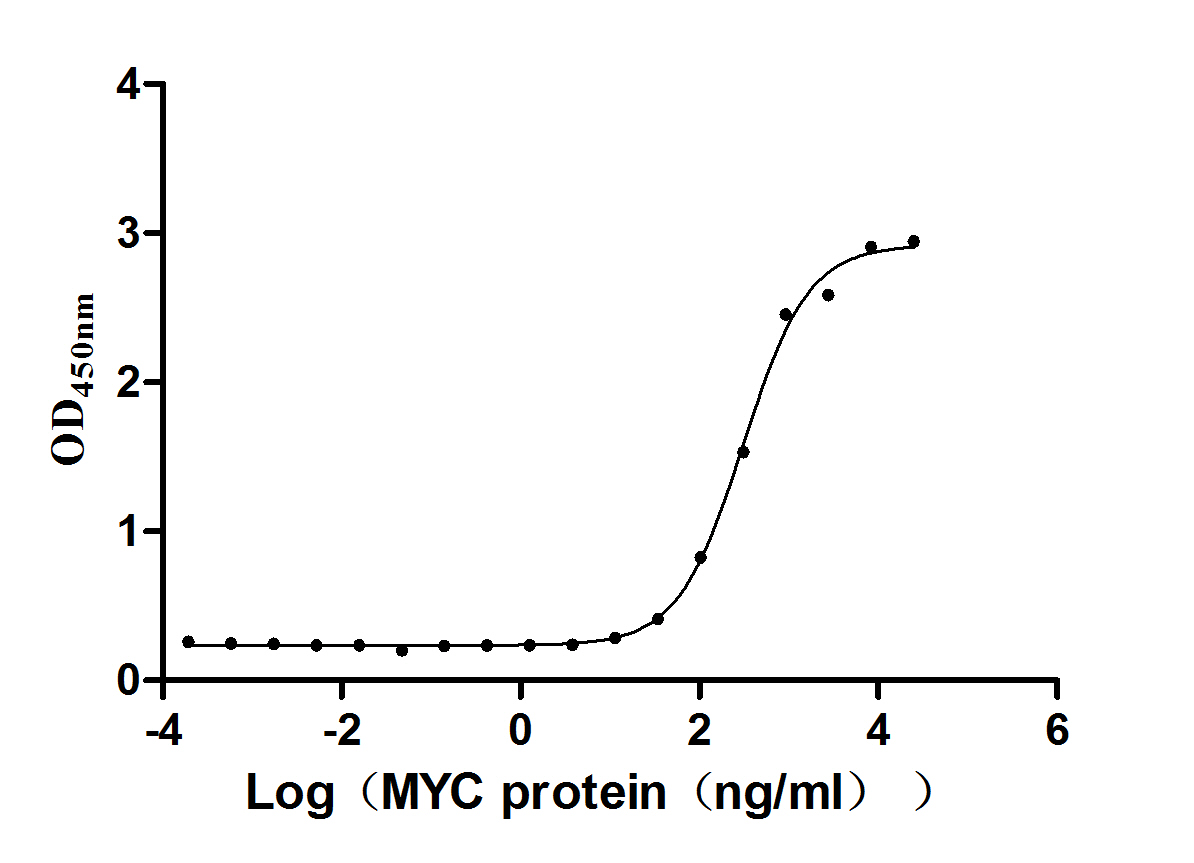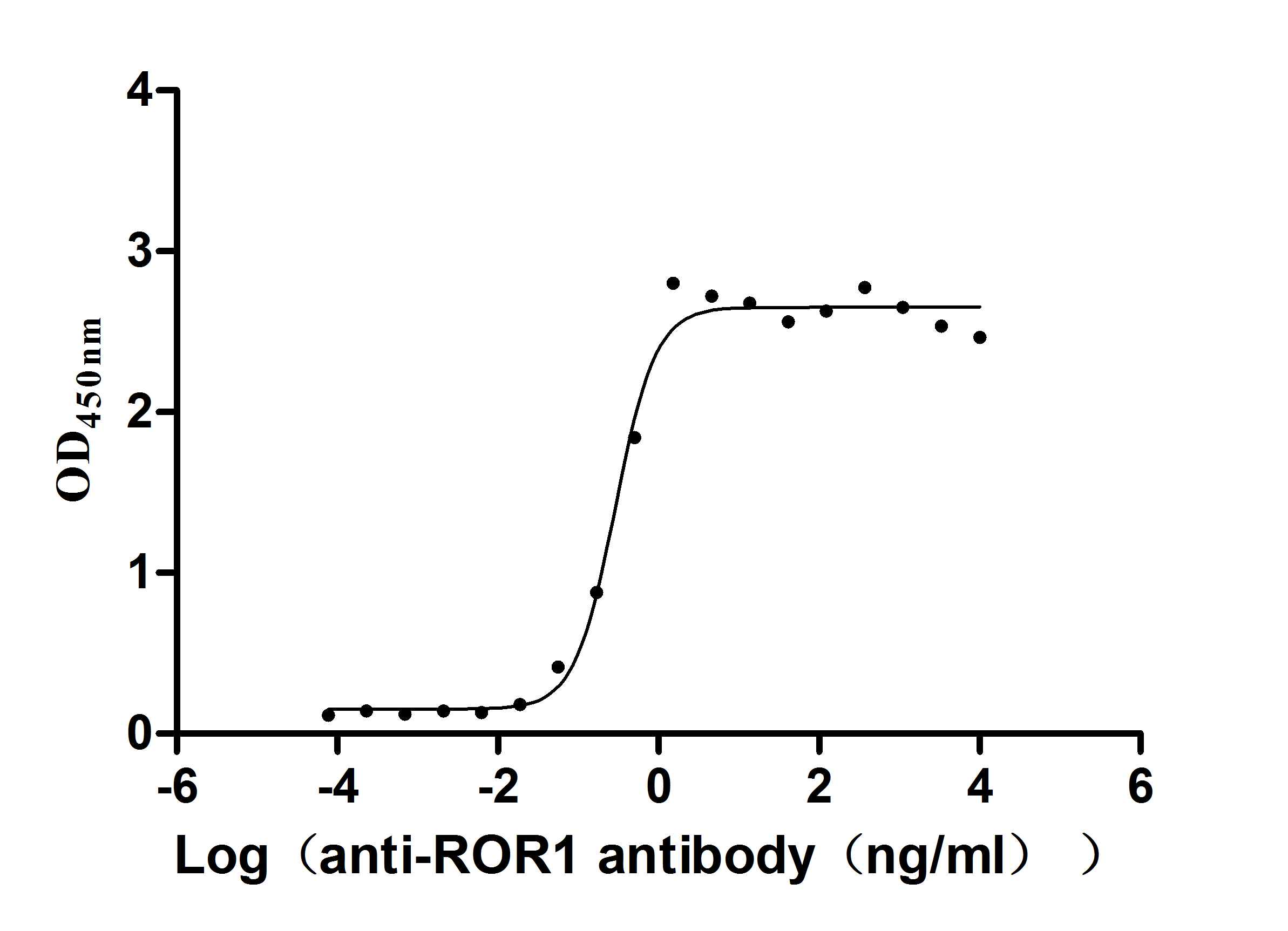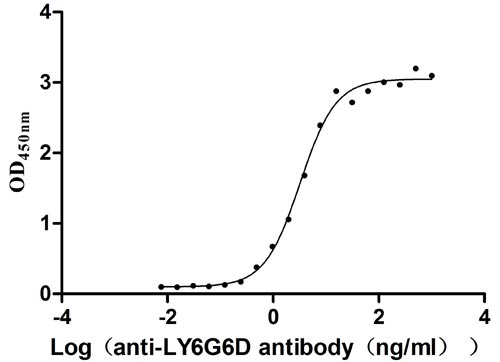Recombinant Mouse Prominin-1 (Prom1),Partial
In Stock-
货号:CSB-EP018751MO
-
规格:¥1836
-
图片:
-
其他:
产品详情
-
纯度:Greater than 90% as determined by SDS-PAGE.
-
基因名:
-
Uniprot No.:
-
别名:Prom1; Prom; Proml1; Prominin-1; Antigen AC133 homolog; Prominin-like protein 1; CD antigen CD133
-
种属:Mus musculus (Mouse)
-
蛋白长度:Extracellular Domain
-
来源:E.coli
-
分子量:48.5kDa
-
表达区域:509-794aa
-
氨基酸序列GANVEKLLCEPYENKKLLQVLDTPYLLKEQWQFYLSGMLFNNPDINMTFEQVYRDCKRGRGIYAAFQLENVVNVSDHFNIDQISENINTELENLNVNIDSIELLDNTGRKSLEDFAHSGIDTIDYSTYLKETEKSPTEVNLLTFASTLEAKANQLPEGKPKQAFLLDVQNIRAIHQHLLPPVQQSLNTLRQSVWTLQQTSNKLPEKVKKILASLDSVQHFLTNNVSLIVIGETKKFGKTILGYFEHYLHWVFYAITEKMTSCKPMATAMDSAVNGILCGYVADPLN
Note: The complete sequence including tag sequence, target protein sequence and linker sequence could be provided upon request. -
蛋白标签:N-terminal 6XHis-SUMO-tagged
-
产品提供形式:Liquid or Lyophilized powder
Note: We will preferentially ship the format that we have in stock, however, if you have any special requirement for the format, please remark your requirement when placing the order, we will prepare according to your demand. -
缓冲液:Tris-based buffer,50% glycerol
-
储存条件:Store at -20°C/-80°C upon receipt, aliquoting is necessary for mutiple use. Avoid repeated freeze-thaw cycles.
-
保质期:The shelf life is related to many factors, storage state, buffer ingredients, storage temperature and the stability of the protein itself.
Generally, the shelf life of liquid form is 6 months at -20°C/-80°C. The shelf life of lyophilized form is 12 months at -20°C/-80°C. -
货期:3-7 business days
-
注意事项:Repeated freezing and thawing is not recommended. Store working aliquots at 4°C for up to one week.
-
Datasheet & COA:Please contact us to get it.
相关产品
靶点详情
-
功能:May play a role in cell differentiation, proliferation and apoptosis. Binds cholesterol in cholesterol-containing plasma membrane microdomains and may play a role in the organization of the apical plasma membrane in epithelial cells. During early retinal development acts as a key regulator of disk morphogenesis. Involved in regulation of MAPK and Akt signaling pathways. In neuroblastoma cells suppresses cell differentiation such as neurite outgrowth in a RET-dependent manner.
-
基因功能参考文献:
- Hypomyelination in CD133(-/-) mice was associated with fewer oligodendrocyte progenitor cells and mature oligodendrocytes. Behavioral analyses revealed that significantly impaired object recognition memory and altered Y-maze performance by CD133(-/-) mice compared with wild-type mice, suggesting perturbed cognitive performance. PMID: 29772232
- Study evaluated the different components of the mouse subventricular zone (SVZ) during the first week after chemical induction of type 1 and type 2 diabetes-like (T1DM and T2DM) conditions. Only T2DM mice showed SVZ damage. The initial lesions were localized to ependymal cilia, which appeared disorientated and clumped together. In addition, they showed delocalization of the ciliary membrane protein prominin-1. PMID: 28743634
- CD133-CD55- common progenitors are the main source of CXCL12 and Kitl producing cells in the developing marrow. PMID: 27929130
- During biliary fibrosis Prominin-1-expressing progenitor cells transdifferentiate into cells within ductular reactions. This transdifferentiation may promote fibrosis. PMID: 28104292
- findings clearly demonstrate that Wnt ligands produced by CD133+ DP cells play an important role in postnatal hair growth by maintaining the inductivity of DP cells and mediating the signaling cross-talk between the mesenchyme and the epithelial compartment PMID: 27462123
- Prom1 positive pulmonary vascular endothelial cells can play a role in local pulmonary vascular homeostasis and repair. PMID: 27059286
- High CD133 promoted stem-ness characteristics and metastasis potential in sphere-forming liver cancer stem cells. PMID: 26735577
- Prom1+ dermal papilla(DP) cells do not contribute to dermal repair but are nevertheless capable of regulating DP size via beta-catenin-mediated intercellular communication. PMID: 26288357
- These findings support PROM1 as a tumor cell-intrinsic marker related to glioblastoma survival, independent of its stem cell properties, and highlight potentially divergent roles for this protein in normal mouse and human glia. PMID: 25184684
- The Prom1-knockout retina showed strong downregulation of expression of the visual cycle components, Rdh12 and Abca4 PMID: 25414197
- Expansion of collagen-producing PROM1 positive cells within regions of periportal fibrosis is associated with activated fibroblast growth factor (FGF) and (TGF)beta pathways in biliary atresia. PMID: 24798639
- CD133 is upregulated during neurogenesis. PMID: 23723983
- CD133, a stem cell marker in mice: results in animal models cannot always be applied to human skin. PMID: 23495873
- role of CD133 in growth of proneural glioma PMID: 23637986
- In vivo tumor growth in NOD/SCID mouse xenografts of liver cancer stem cells were significantly repressed after CD133 silencing. PMID: 23233126
- CD133 modifies frequencies of growth-factor responsive hematopoietic progenitor cells during steady state and after myelotoxic stress in vivo. PMID: 23509298
- a net decrease in hippocampal neurogenesis, by 30% was found in Prominin-1 knock-out mice PMID: 23407958
- Evidence for self-renewal capacity was obtained by serial transplantation of long-term epidermal repopulating units derived from CD133(+) and CD133(+)DeltaPsim(hi) keratinocytes. PMID: 22763787
- CD133-positive glioma stem-like cells isolated from murine transplanted gliomas exhibit higher invasive potential after being cocultured with tumor-associated microglia/macrophages. PMID: 22664874
- The microenvironment of the inflamed fibrotic lung impairs the regenerative capacity of bone marrow-derived prominin-1+ progenitor cells and promotes their differentiation into pathogenic phenotypes. PMID: 21943210
- MiR-34a targeting of Notch ligand delta-like 1 impairs CD15+/CD133+ tumor-propagating cells and supports neural differentiation in medulloblastoma PMID: 21931765
- increased CD133 expression occurs at early stages of colon tumorigenesis in the mouse PMID: 22199291
- Sox17 might be a key transcription factor controlling CD133 expression, and that it might also play a role in the control of gastric tumor progression. PMID: 21457403
- Data reveal a novel, functional role for Prom1 that is not related to stem cell activity, and demonstrate the importance of tissue-specific characterization of putative stem cell markers. PMID: 21337465
- CD133 positivity defines a genetically distinct cellular compartment in primary colorectal cancer cells PMID: 21435437
- analysis of CD133/prominin in human and mouse cells PMID: 21187924
- In addition to conserved expression of prominin-1 in photoreceptors, significant prominin-1-expressing non-photoreceptor retinal cell populations are present in the vertebrate eye. PMID: 21407811
- Mouse prominin-1 is widely expressed in prostate whereas in human only some luminal cells express it PMID: 20717901
- CD133, CD15/SSEA-1, and CD34 do not resume tumor-initiating properties of long-term cultured malignant glio-neuronal stem cells PMID: 20181261
- CD133 may have a role in chemo-resistant Ewing sarcoma cells PMID: 20346143
- the majority of mouse prominin-1 splice variants are widely expressed in mouse tissues PMID: 20808829
- This study showed that resident microvascular CD133+ pericytes with presumptive stem cell potential are sensitive to spinal cord injury. PMID: 20374199
- Our data show that CD133 expression is not selective for sphere forming, tumor-initiating or radioresistant subpopulations in the HCT-116 CRC cell lines. PMID: 19699546
- prominin-1 is involved in the formation and/or stabilization of epididymal stereocilia and the tail of spermatozoa, and hence might play a dual role in the biogenesis of spermatozoa. PMID: 15316084
- prominin-1/CD133 is expressed in embryonic stem cell-derived progenitors PMID: 15917475
- colorectal cancer is created and propagated by a small number of undifferentiated tumorigenic CD133+ cells, which should therefore be the target of future therapies PMID: 17122771
- We propose that the prominin-1/CD133 is a novel surface marker useful for collecting dermal papilla (DP) cells in the anagen stage and for analyzing the function of DP. PMID: 17185982
- Apical midbodies of neuroepithelial cells concentrate prominin-1 (CD133), a somatic stem cell marker and defining constituent of a specific plasma membrane microdomain. PMID: 17283184
- These data suggest that CD133-positive brown adipose tissue-derived cells are a useful tool as cardiomyocytes (CM) inducers, as well as a source of CMs. PMID: 17289932
- expression of the marker Prominin-1 and in the three pairs of major salivary glands, i.e., submandibular-, major sublingual-, and parotid glands in mice PMID: 17874118
- CD133(+) ependymal cells represent an additional-perhaps more quiescent-stem cell population in the mammalian forebrain PMID: 18195354
- CD133 has roles in metastatic colon cancer and is expressed in colon cancer stem cells PMID: 18497883
- CD133 expression is not restricted to intestinal stem or cancer-initiating cells, and during the metastatic transition, CD133+ tumor cells might give rise to the more aggressive CD133(- )subset, which is also capable of tumor initiation in NOD/SCID mice PMID: 18497886
- Prominin-1+/CD133+ bone marrow-derived heart-resident cells suppress experimental autoimmune myocarditis. PMID: 18621802
- CD133(+)CD44(+) population had the ability to produce colon tumor. PMID: 18663533
- This study suggest that complex expression pattern of prominin-1 molecules in developing adult brain. Given that prominin-1 is thought to act as an organizer of plasma membrane protrusions. PMID: 19053060
- data indicate that Prom1 marks stem cells in the adult small intestine that are susceptible to transformation into tumours retaining a fraction of mutant Prom1(+) tumour cells PMID: 19092805
- CD133(+)CD45(-) oval cells isolated from premalignant 16-month-old Mat1a(-/-) mice demonstrated significant resistance to transforming growth factor-beta-induced apoptosis compared to CD133(-) cells. PMID: 19115422
- Loss of Prom-1 results in progressive degeneration of mature photoreceptors with complete loss of vision. PMID: 19228982
- Data suggest the possibility that CD133 may be specifically down-regulated during G0/G1, and this should be considered when this marker is used to identify and isolate other tissue and cancer stem cells. PMID: 19430532
收起更多
-
亚细胞定位:Apical cell membrane; Multi-pass membrane protein. Cell projection, microvillus membrane; Multi-pass membrane protein. Cell projection, cilium, photoreceptor outer segment. Endoplasmic reticulum. Endoplasmic reticulum-Golgi intermediate compartment. Note=Found in extracellular membrane particles in various body fluids such as ventricular fluid of the developing brain and urine.
-
蛋白家族:Prominin family
-
组织特异性:In the submandibular gland, expressed on the apical side of epithelial cells. In the parotid gland, expressed in the intercalated ducts. In the sublingual gland, expressed in intercalated ducts. In the extraorbital lacrimal gland, expressed in the interca
-
数据库链接:
KEGG: mmu:19126
STRING: 10090.ENSMUSP00000073751
UniGene: Mm.6250

